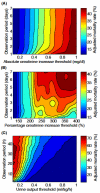Empirical relationships among oliguria, creatinine, mortality, and renal replacement therapy in the critically ill
- PMID: 23223822
- PMCID: PMC3580030
- DOI: 10.1007/s00134-012-2767-x
Empirical relationships among oliguria, creatinine, mortality, and renal replacement therapy in the critically ill
Abstract
Purpose: The observation periods and thresholds of serum creatinine and urine output defined in the Acute Kidney Injury Network (AKIN) criteria were not empirically derived. By continuously varying creatinine/urine output thresholds as well as the observation period, we sought to investigate the empirical relationships among creatinine, oliguria, in-hospital mortality, and receipt of renal replacement therapy (RRT).
Methods: Using a high-resolution database (Multiparameter Intelligent Monitoring in Intensive Care II), we extracted data from 17,227 critically ill patients with an in-hospital mortality rate of 10.9 %. The 14,526 patients had urine output measurements. Various combinations of creatinine/urine output thresholds and observation periods were investigated by building multivariate logistic regression models for in-hospital mortality and RRT predictions. For creatinine, both absolute and percentage increases were analyzed. To visualize the dependence of adjusted mortality and RRT rate on creatinine, the urine output, and the observation period, we generated contour plots.
Results: Mortality risk was high when absolute creatinine increase was high regardless of the observation period, when percentage creatinine increase was high and the observation period was long, and when oliguria was sustained for a long period of time. Similar contour patterns emerged for RRT. The variability in predictive accuracy was small across different combinations of thresholds and observation periods.
Conclusions: The contour plots presented in this article complement the AKIN definition. A multi-center study should confirm the universal validity of the results presented in this article.
Figures


Comment in
-
eResearch: the case of acute kidney injury.Intensive Care Med. 2013 Mar;39(3):522-3. doi: 10.1007/s00134-012-2768-9. Epub 2012 Dec 7. Intensive Care Med. 2013. PMID: 23223823 No abstract available.
References
-
- Chertow GM, Burdick E, Honour M, Bonventre JV, Bates DW. Acute kidney injury, mortality, length of stay, and costs in hospitalized patients. J Am Soc Nephrol. 2005;16:3365–3370. doi: 10.1681/ASN.2004090740. - PubMed
-
- Barrantes F, Tian J, Vazquez R, Amoateng-Adjepong Y, Manthous CA. Acute kidney injury criteria predict outcomes of critically ill patients. Crit Care Med. 2008;36:1397–1403. doi: 10.1097/CCM.0b013e318168fbe0. - PubMed
-
- Cruz DN, Bolgan I, Perazella MA, et al. North East Italian Prospective Hospital Renal Outcome Survey on Acute Kidney Injury (NEiPHROS-AKI): targeting the problem with the RIFLE Criteria. Clin J Am Soc Nephrol. 2007;2:418–425. doi: 10.2215/CJN.03361006. - PubMed
Publication types
MeSH terms
Substances
Grants and funding
LinkOut - more resources
Full Text Sources

